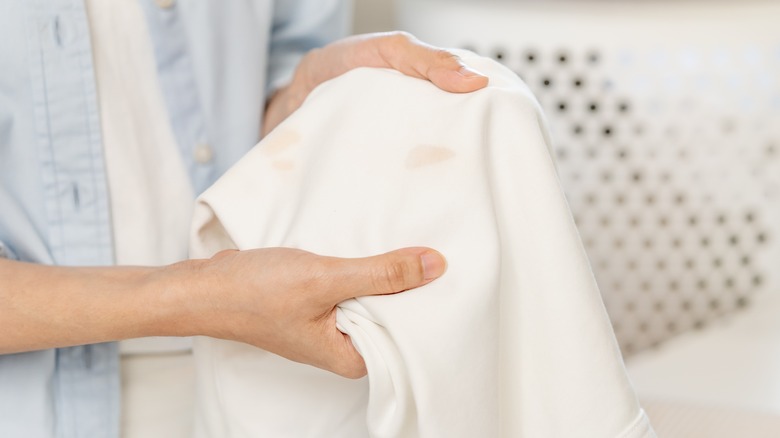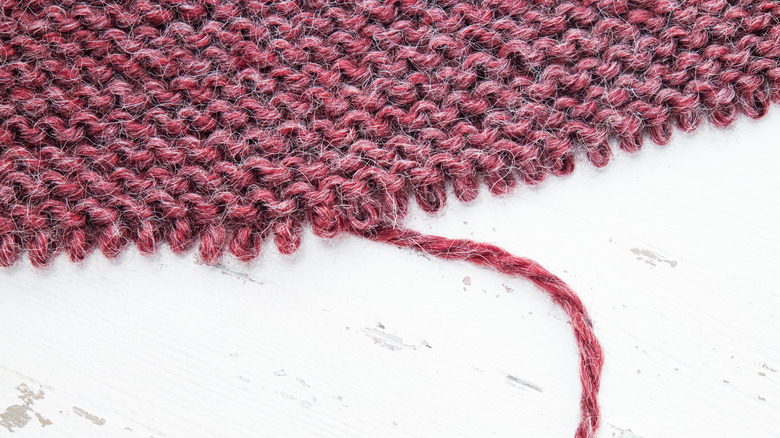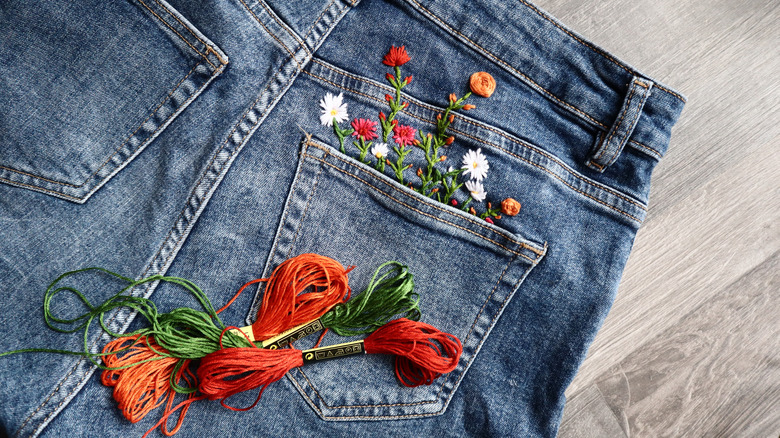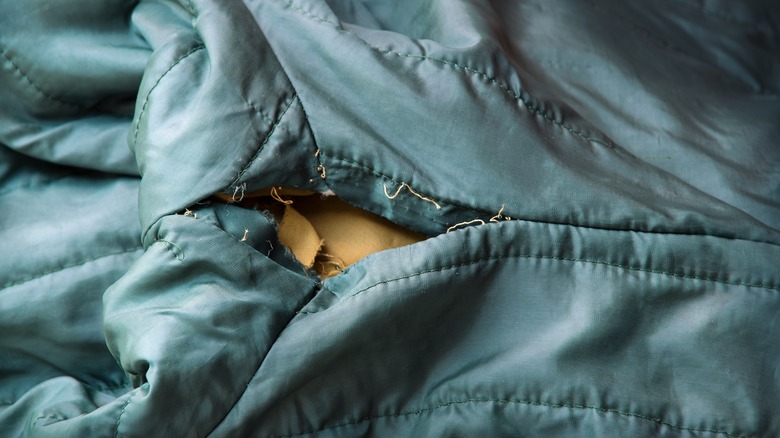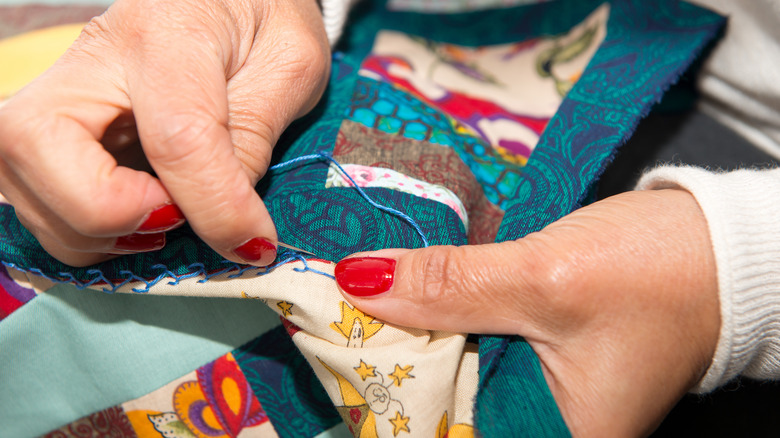Repairing Your Damaged Fashion Pieces Is One Of The Easiest Ways To Embrace Sustainability
We may receive a commission on purchases made from links.
Sustainability is a frequent topic of conversation in fashion, but often, the discussion centers around buying new products from slow fashion instead of fast fashion retailers. This is, of course, important — according to a report from the United Nations Alliance for Sustainability, the fast fashion industry accounts for anywhere from 2% to 8% of global carbon emissions — but the most sustainable thing you can do is not purchase new clothing in the first place.
Of course, everyone needs to invest in a few new items now and then, but your first major step into sustainability should always focus on your own closet, even if it's comprised of pieces from Shein or H&M. Trashing these items in favor of more ethical brands only does more to worsen the problem, so instead, try and extend their lives as much as possible. Proper laundering and storage can go a long way in ensuring your pieces last, but sometimes, you'll have to make a few simple repairs. Luckily, this doesn't mean you have to be a seamstress or own an expensive sewing machine. Some of the most common issues can be tackled with little more than a needle and thread.
Get rid of set-in stains
Staining is one of the most common reasons clothing gets tossed to the side or replaced, but with a bit of TLC, you should be able to make your favorite white tee wearable again. Proper treatment all depends on the type of stain you're facing, but if you have the option, it's best to try and remove any spots as soon as possible instead of waiting until laundry day to tackle the issue. Most stains will easily lift with a bit of stain remover or bleach, but vinegar and hydrogen peroxide are popular household products that can help clear up the issue, too.
If you're working with an item that has a stain that just won't budge, however, you have a few options. The first, and by far the easiest, is cropping the item. A shirt with a stain towards the hem can easily be transformed into a trendy cropped tee with a pair of fabric scissors. If the stain is in a less convenient area, however, consider dying the item. Brands like Rit carry easy-to-use dyes that can completely transform a once-sidelined piece of clothing.
Fix snagged knitwear
Nothing beats a soft, cozy sweater during the winter months, but, with frequent wear, snags are unavoidable. Because of knits construction, a simple snag can quickly turn into a larger problem, so it's best to repair the issue as soon as possible. Thankfully, this is an easy fix — no sewing or knitting skills required.
To repair your knit's snags, all you need is something thin and sharp, preferably metal or plastic so it doesn't further catch in the fabric. Something like a crochet hook, bobby pin, or safety pin works in a pinch (via Instructables). Find the pulled thread, then work your way around it, hooking and gently pulling to evenly distribute the tension back to the other loops that have been tightened. If you need a quick repair while you're out and about, find the loose loop on the inside of the fabric, then use a similar tool to pull it back through the knit to disguise it.
Cover minor holes
When it comes to small holes in fabric, you have quite a few options for repairs. One of the easiest is patching. This is especially common on worn denim, but it can be used with other sturdy fabrics as well. Find your damaged area, then grab a bit of scrap fabric or a pre-cut patch from a craft store. Turn the item inside out, then sew or iron on the patch as a reinforcement to prevent further damage.
For extra-tiny holes, the repair can even be as simple as a stitch or two. Find a matching thread, then sew the edges of the fabric together, making sure to relax on the tension a bit so you're not left with an unsightly pucker. This process can even be turned into an art project if you're feeling more creative. Try out some simple embroidery stitches to both disguise holes and add a splash of personalization to your more basic pieces.
Stitch ripped seams
One of the areas that fast-fashion brands tend to sacrifice quality on is the seams, so you've likely experienced a rogue hole under the arms or along the side of an item of clothing after a bit of wear and tear. Repairing these areas, however, is actually incredibly simple. All it takes is a bit of stitching, and because seams are usually more hidden, it doesn't have to look absolutely perfect.
If the edges of the fabric along the seam are fraying, however, it might require an extra step. Obviously, a serger would do the trick, but these single-use machines are usually only worth the investment if you frequently sew and make your own clothes. For a more accessible and low-cost way to stop the edge of the fabric from unraveling further, trim any excessive frays, then pick up some heat-activated bias tape like this HeatnBond Hem Iron-On Adhesive. Fold it over the edge then apply gentle heat to seal, and you'll be left with a more workable piece of fabric that you can then mend.
Create something new
Sometimes, the damage to your existing pieces is more serious than a simple stain or pull, but that doesn't mean that it needs to go straight into the trash. Instead, consider what you can do to rework the item you have. Removing sleeves or shortening a hem are fairly simple changes that don't require major reimagination, but big switches can be accomplished with the help of a tailor if you don't have the tools yourself, often for much cheaper than the cost of a new item.
Finally, there's always the option to reuse the fabric. Old tees and flannels can be cut into rags or filling for pillows, and sturdier materials like denim can be used as patches to extend the life of your other items — or you can even start making quilts or patchwork skirts. Obviously, nobody is environmentally perfect, but by changing your perspective and focusing on increasing the longevity of your clothing, you can seriously reduce your negative impact.

